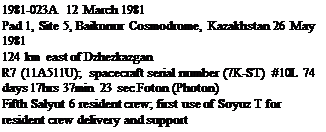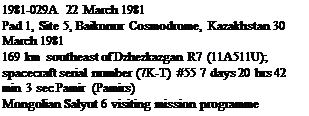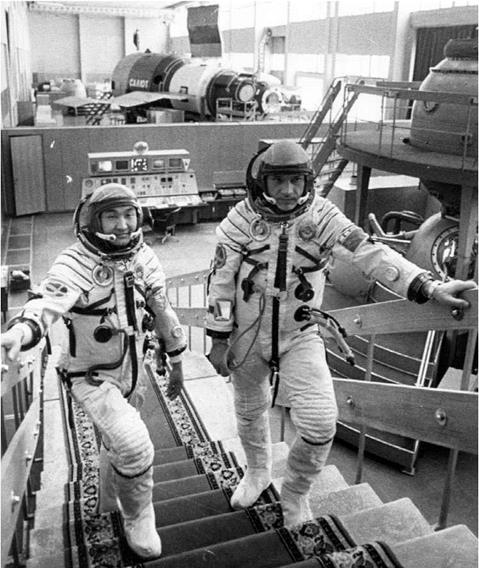The Third Decade: 1981-1990

 |
Flight Crew
KOVALENOK, Vladimir Vasilyevich, 39, Soviet Air Force, commander, 3rd mission
Previous missions: Soyuz 25 (1977); Soyuz 29 (1978)
SAVINYKH, Viktor Petrovich, 41, civilian, flight engineer
Flight Log
The long-duration mission of Soyuz T4 was not originally intended as such but was more the result of rescheduling after the Soyuz 33 docking abort cancelled some international Interkosmos flights, leading to a situation where a Mongolian and a Romanian were still to visit Salyut. The station had fortunately been given a stay of execution by the Soyuz T3 mission. Soyuz T4, set for a mission that would last long enough to accommodate the two Interkosmos missions and verify a new Soyuz spacecraft for a period of extended docking with Salyut, took off at midnight from Baikonur, the second such launch since Soyuz 9. On board were Vladimir Kovalenok, who was already rather familiar with Salyut 6, and his flight engineer, Viktor Savinykh. Though he was a rookie, Savinykh nevertheless had the unique statistic of being both the hundredth person and the fiftieth Soviet to enter space. As the two visiting crews had not trained on Soyuz T and were not qualified to return in one, the resident crew would not have an exchange of vehicle to support an extended-duration mission, so no attempt would be made to exceed the space flight endurance record on this mission.
After docking with Salyut, the crew unpacked Progress 12 and finished off some refurbishment work, including repairs to a battery unit and a condensation unit on the thermal control system. This was necessary because only one solar panel was generating enough power, and as a result excessive condensation was forming inside the station. Kovalenok and Savinykh then discarded Progress 12, the last unmanned tanker to berth at Salyut 6, and prepared for their first visit, on 23 March, by the
|
End of an era. The T4 crew’s return to Earth brought Salyut 6 operations to a close. The crew is seen here displaying the national emblems of the communist countries whose representatives visited the station during the Soviet and Interkosmos missions between 1977 and 1981 |
Mongolian mission of Soyuz 39. After the brief visit, the crew then changed the docking unit on Soyuz T4, possibly to demonstrate the space rescue capability. By taking the docking unit out of Soyuz, it was possible to dock another Soyuz with it, in an operation that may have been prompted by the near disaster on Soyuz 33 when the two crewmen could have been left stranded in space. Another international mission followed on 15 May, this time by a Romanian, before Kovalenok and Savinykh mothballed Salyut 6 for the last time and headed home.
Soyuz T4 landed at T + 74 days 17 hours 37 minutes 23 seconds, 124 km (77 miles) east of Dzhezkazgan. Maximum altitude achieved during the mission was 374 km (232 miles), at 51.6°. The mission of Salyut 6 was not over, however, as a new module called Cosmos 1267, the same size as Salyut, docked with it on 19 June, remaining in orbit until the whole combination was de-orbited in July 1982. The Cosmos 1267 Heavy Cosmos module, flight tested as Cosmos 929, was launched by a Proton booster on 25 April. It performed extensive orbital manoeuvres and even dispatched an unmanned re-entry capsule back to Earth for recovery on 15 May. Further orbital manoeuvres were made by the joint craft and it became evident that future Salyuts and other generation space stations would be enlarged by the addition of other Heavy Cosmos derivatives. Salyut 6 was not manned again after the end of the T4 mission.
It re-entered the atmosphere in July 1982, once Salyut 7 had been successfully placed in orbit to replace it. Salyut 6 had been an outstanding success for the Soviet Union, at a time when all bar three US astronauts were grounded between the end of Apollo and the beginning of the Shuttle program.
Milestones
78th manned space flight 47th Soviet manned space flight 40th Soyuz manned space flight 3rd Soyuz T manned space flight 100th person in space

 |
Flight Crew
DZHANIBEKOV, Vladimir Aleksandrovich, 38, Soviet Air Force, commander, 2nd mission Previous mission: Soyuz 27 (1978)
GURRAGCHA, Jugderdemidyin, 33, Mongolian People’s Army, cosmonaut researcher
Flight Log
During the 1960s, the name of a certain Nigerian leader used to terrify newscasters. The name of the next spaceman could also have caused apoplexy in newsrooms around the world had he not been the one-hundred-and-first and a Mongolian. Jugderdemidyin Gurragcha and his commander Vladimir Dzhanibekov were launched at 19:59 hrs local time from the Baikonur Cosmodrome and a day later were inside Salyut 6 with residents Kovalenok and Savinykh. The experiments were mainly medically oriented, but also included Gurragcha’s photography of his homeland to conduct an Earth resources survey of oil, gas and mineral deposits, and the use of a visual polarising analyser to assess the effects of prolonged exposure to space on the station’s portholes.
Maximum altitude achieved during the 51.6° mission was 355 km (221 miles). Gurragcha may have been one of the few space travellers to have reacted violently to weightlessness. Only one photo of him aboard Salyut 6 has ever been released, but he seemed in good spirits after landing in fog and drizzle at T + 7 days 20 hours 42 minutes 3 seconds, 169 km (105 miles) southeast of Dzhezkazgan.
Milestones
79th manned space flight 48th Soviet manned space flight
|
|
|












